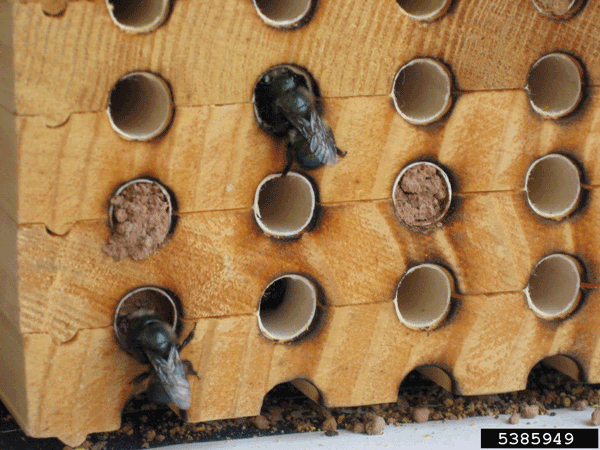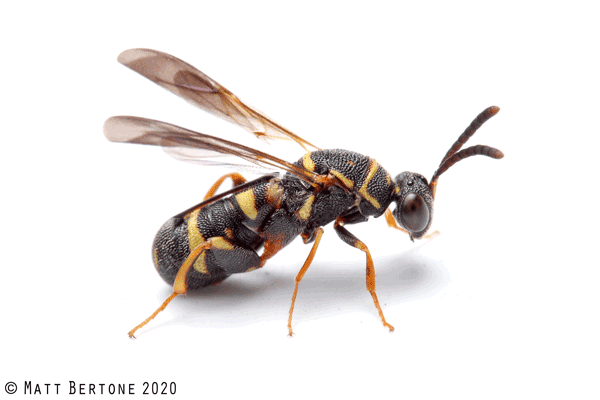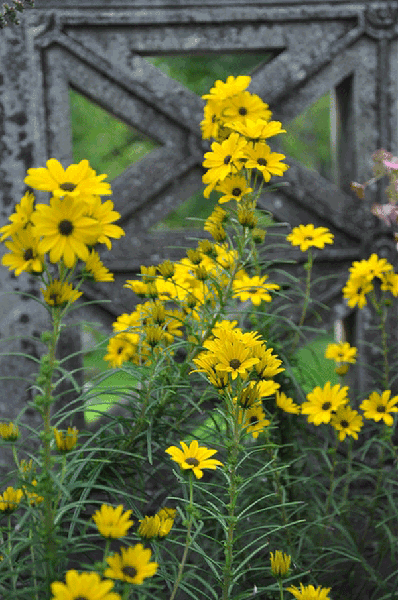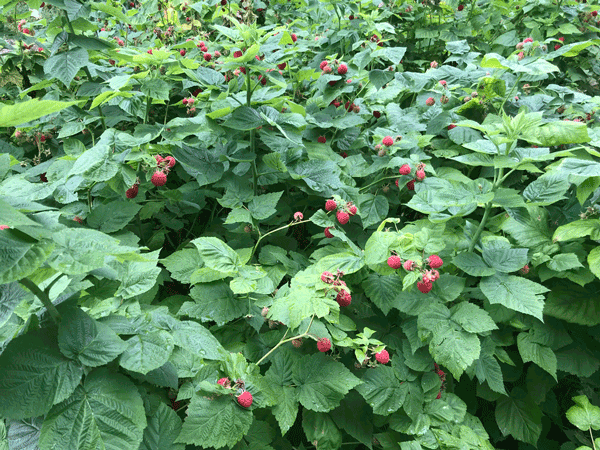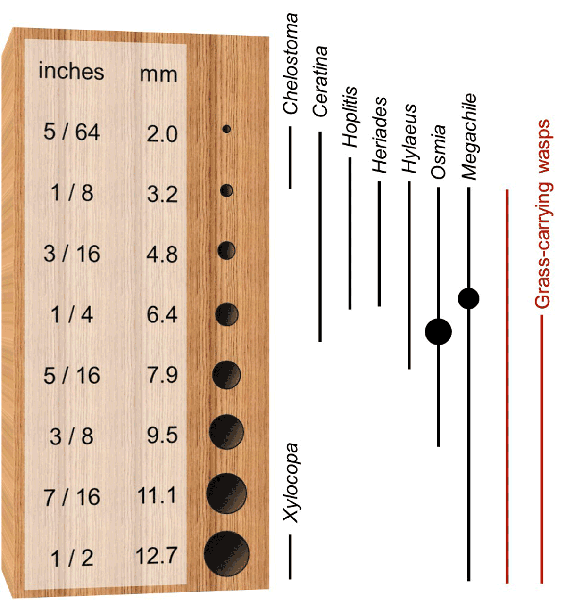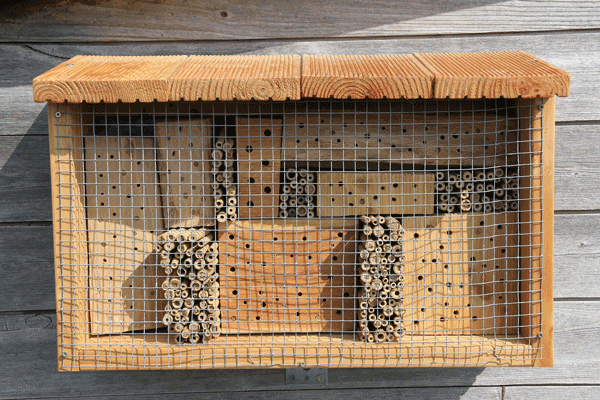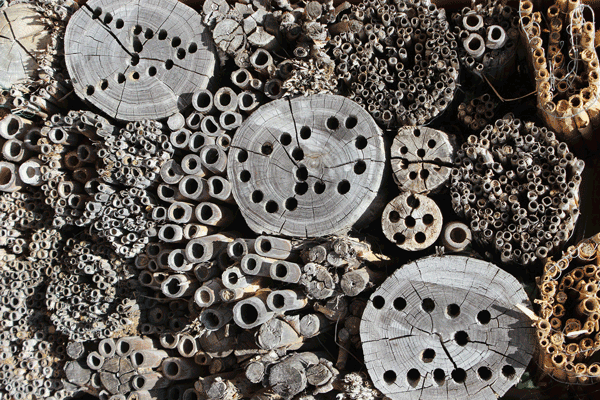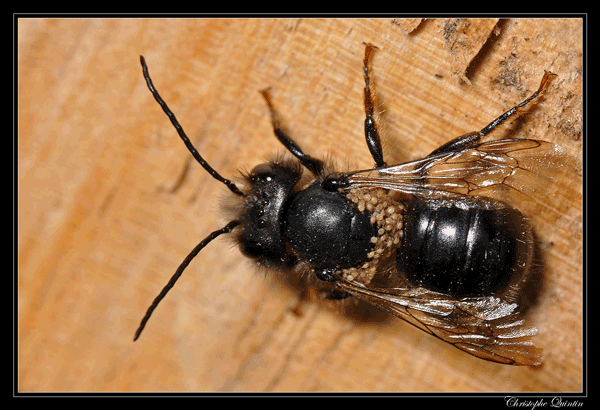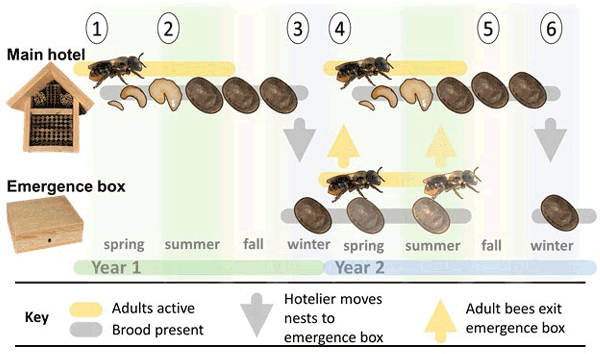There is a tremendous variety of bee hotels (and bee hotel plans) available online, and it can be hard to choose a good one. Much of what we know about artificial nest design comes from research in just a few commercially managed species, or short-term studies of other species. Some common recommendations are based on expert opinion, which may be sound but lacks a documented evidence base. This patchy knowledge can be frustrating, but it also means there’s room to innovate and tinker with your own bee hotel. There is no single, perfect bee hotel—but to help you make informed and logical decisions, this section explains key considerations for bee hotel design and placement based on documented research and on our experience in Raleigh, North Carolina.
No matter the type of nesting material you choose, keep your bee hotel structure modest in size, fewer than about 100 nesting tunnels per hotel. Research in blue orchard bees shows that nest boxes with more than 100 holes are less attractive (Artz et al. 2014; Artz et al. 2013). In contrast, introduced alfalfa leafcutting bees in commercial fields prefer very large, conspicuous nesting structures with tens of thousands of tunnels (Stephen 1981). Most native species, however, are not so gregarious (Richards 1984). Although an optimal bee hotel size has yet to be determined, logic and ease of maintenance suggest that smaller structures will appeal to more species and be more successful. In a home yard or garden, one hotel is probably plenty—or perhaps a couple if you want to experiment with different designs or locations.
Finally, to accompany any bee hotel, you’ll need an emergence box (sometimes also called a hatch house). This box helps keep the main bee hotel clean and healthy by providing a transitional area for used nesting materials. If re-used year after year, nests can build up parasites and diseases. The emergence box lets emerging bees escape but prevents them from re-using the same dirty tubes—which you can then clean or retire. Some bee hotels have emergence boxes built in as a drawer or compartment of the main hotel; it can also be a completely separate structure. Details about emergence boxes, cleaning, and maintenance are included in the Shelter and Protection section.
Materials for Nest Tunnels
The functional core of a bee hotel is the nesting material itself. This can take four basic forms—drilled blocks, grooved boards, observation nests, or bundled tubes. Each material has advantages and disadvantages, described below. Some bee hotel shelters include multiple cubbies that hold different nesting materials, so you don’t have to make an either-or decision among the four types. In fact, providing a variety of nesting materials may help attract a greater diversity of bees (Geslin et al. 2020; Fortel et al. 2016). Pinecones, loose bark, and moss, however, are not (or very rarely) used by nesting bees and wasps (Hawkins 1975; González-Zamora et al. 2021). Even though you’ll see these materials in some commercial insect houses, we don’t recommend them in a bee hotel.
Drilled blocks (Figure 39) are made by drilling holes into chunks of logs, branches, or untreated wood. These are often quite attractive to nesting bees and wasps (González-Zamora et al. 2021) but are difficult to clean or inspect unless each hole is lined with a paper or cardboard insert. (Otherwise, remnants of failed nests—and any associated diseases—are impossible to completely remove.) The nest tunnels don’t go all the way through the block; each tunnel has an open end and a solid, closed end. Nest entrances should be smooth and free of splinters that could deter bees or damage their wings (von Königslöw et al. 2019).
Grooved boards, when stacked, simulate drilled blocks, but facilitate seasonal cleaning and inspection because each nest tunnel can be exposed by unstacking the boards (Figure 40). Opening the grooves damages active nests and should only be done in the winter when nests are complete and bees are dormant.
Grooves usually extend the entire length of the grooved board, and the stack of boards needs to be placed with one end snug against a vertical surface to effectively close one end of the tunnels. In our experience (and others’ [González-Zamora et al. 2021]), grooved boards are less attractive than drilled blocks or bundled tubes, but many users have reported success (von Königslöw et al. 2019; Dicks et al. 2010; Sedivy and Dorn 2014).
In both drilled blocks and grooved boards, the nest tunnels should be positioned at least 3/4″ from the edge of the block or stack. Following this guideline reduces parasitism by the wasp Leucospis affinis, a common parasite of mason bees, leafcutting bees, resin bees and, occasionally, solitary wasps (Krombein et al. 1979; Cowan 1986) (Figure 41). A Leucospis female approaches the nest of her host from the outside and can use her ovipositor (egg-laying appendage) to penetrate up to 3/4″ through the nest wall to lay an egg inside a bee’s nest chamber (Bosch and Kemp 2001). The wasp herself is only about 0.3 to 0.4″ long, but she can extend her ovipositor about twice her own body length into solid wood, a process that requires about 10 minutes to lay a single egg (Graenicher 1906; Bosch and Kemp 2001). Once the Leucospis larva hatches, it feeds gradually on the living bee larva for a few days until only an empty husk remains (Graenicher 1906). Many other species of flies, wasps, and mites can also parasitize bee nests; in many cases, prevention is an issue of maintenance rather than design (see ).
Observation nests consist of a single, deeply grooved board covered by a plexiglass viewing panel (Figure 42). The plexiglass is concealed behind a door to keep the nest interior dark except when someone wants to look inside. Observation nests can be a great opportunity to peek at nesting activity in real time. Of course, they’re more expensive to purchase (or more complicated to construct), and generally offer fewer tunnels for residents to use—only one or two rows.
Bundled tubes can include a variety of purchased or found plant stems (Figure 43). Nesting tubes are closed at one end. Reeds or bamboo, cut at a node, are popular because they naturally have one open end and one closed end. Pre-cut reeds, sorted by diameter, are commercially available for use in bee hotels. Hollow and pithy stems and twigs can also be harvested from plants in a home landscape (Figures 44a, 44b, and 44c) and bundled for use in bee hotels. Appendix 3 lists plants with stems that are used by nesting bees in eastern North America.
Do not use cardboard, paper, glass, or plastic tubes in nesting bundles. Drinking straws can be tempting because they are about the right size, but nests in plastic straws are often ruined by mold, while those in paper straws are often parasitized (Dicks et al. 2010; Fye 1965; Stephen and Every 1970). Glass tubes also accumulate moisture and mold (Krombein 1967). Paper and cardboard tubes are commercially available for use in bee hotels, but, because they are so susceptible to parasitism (Dicks et al. 2010; Stephen and Every 1970; Krunić et al. 2005), we do not recommend using them in bundles (Figure 45). Paper and cardboard tubes can, however, be used to line drilled blocks or grooved boards. In this setting, the tubes are well protected from parasites, and the removable tubes facilitate seasonal cleaning.
Summary: Best Practices for Nest Tunnel Materials
-
Use only natural, breathable materials such as wood, twigs, and plant stems, not plastic or glass. (A plastic panel in an observation nest is OK when the rest of the nest is wooden.)
-
All tunnels should have smooth entrances, free of splinters or cracks.
-
Paper and cardboard tubes are OK to line drilled wooden tunnels, but not as stand-alone materials.
-
Avoid pinecones, moss, and bark, which are not used by nesting bees and wasps.
-
Keep the total number of tunnels in a bee hotel under 100.
-
In drilled blocks and grooved boards, nests should start at least 3/4″ from the edge of the block or stack.

Figure 45. Monodontomerus wasps lay eggs in the nest chambers of Osmia and Megachile, where their larvae feed on the immature bees. These wasps are tiny and their ovipositors are not very long, but they can easily penetrate paper tubes and other thin-walled nest tunnels (Krunić et al. 2005).
Slimguy, Wikimedia
Tunnel Size
Diameter. Whether you use drilled blocks, grooved boards, observation nests, or bundled tubes, the diameter of the nesting tunnel determines which species can use it. Across all species, bees and wasps will occupy nest tunnels with diameters that approximately match their own body size, generally between just over 1/16 inch to about 1/2 inch (Figure 46). Ceratina generally requires pithy stems and is not found in wooden blocks (it is included in Figure 46 for comparison only). Tunnel size also limits the size of the offspring that develop inside (Stephen and Osgood 1965). Residents who can’t find an optimal tunnel may use other sizes, but these nests are generally less successful (MacIvor 2017).
Nest diameter affects offspring size and sex in a few ways. First, bees who develop in nest chambers stocked with more food grow up to be bigger adults (Helm et al. 2017; Krombein 1967). Smaller tunnels hold less food, so they produce smaller bees. Second, even in the best of circumstances, male bees are usually smaller than females. The mother bee controls when she’s going to lay a female egg (which is fertilized) versus a male egg (which is not). When faced with a smaller nest, she fills it with the better-fitting offspring: males. Similar patterns are documented in several species of mason bees, leafcutting bees, and wasps (Tepedino and Parker 1983; Longair 1981; Gerber and Klostermeyer 1972; Stephen and Osgood 1965; Bosch and Kemp 2001; Tepedino and Torchio 1989). If only too-small nests are available for a given species, the small, male-skewed brood can be problematic for the overall population. Smaller individual bees are less likely to survive and reproduce (Tepedino and Torchio 1989); males are usually less effective pollinators (Stephen and Osgood 1965), and a male-skewed population may not have enough nest-making moms to maximize the next generation.
Meanwhile, nests that are too wide have their own problems. Mother bees have to collect more construction materials and modify the interior design to make the nest fit better (thereby wasting time and energy that they could be using to collect pollen and lay eggs) (Stephen and Osgood 1965; Seidelmann et al. 2016). In some cases, the modified interiors of wide nests may be linked to lower survival of the developing larvae (Tepedino and Parker 1983).
Length. As with diameter, ideal nest length varies among species. For example, research with alfalfa leafcutting bees find nests between 2 and 3″ long to be most efficient (Stephen and Osgood 1965), while blue orchard bees (and their similarly sized relatives) do well with 6″ nests (Bosch and Kemp 2001; Gruber et al. 2011; Seidelmann et al. 2016). A bee forced to use the “wrong” nest length may produce fewer total offspring or fewer female offspring.
Too-short tunnels have two main disadvantages. First, the mother bee may construct only one or two nest chambers in a too-short tunnel before she has to waste time and energy to seal it up and search for a new tunnel (Stephen and Osgood 1965). Second, mother bees fill their nests from back to front, with female offspring in the back and males near the entrance. When a nest-building mom senses that she is nearing the entrance, she switches to laying male eggs (Gerber and Klostermeyer 1972). If a nest is too short, she lays fewer female eggs before reaching the male zone near the entrance (Stephen and Osgood 1965; Gerber and Klostermeyer 1972; Seidelmann et al. 2016). The downsides of a too-short nest are similar to those of a too-narrow nest: smaller bees and male-skewed broods.
Longer isn’t always better, either. For example, alfalfa leafcutting bees waste space when they nest in tunnels longer than about 3″ because they only use short sections of each tunnel (Stephen and Osgood 1965). Moreover, when these bees build long nests with many chambers, the offspring that emerge in the very back can have trouble getting to the entrance through all the nest parts, debris, or dead siblings that block their way (Stephen and Osgood 1965). While some users have reported success with longer tunnels—up to 12″ for blue orchard bees—these have only been tested with very hands-on management, where cocoons were removed manually (see page 39). Bees might have trouble emerging on their own from such long tunnels.
Summary: Best Practices for Tunnel Size
- To support a diversity of species, and balanced sex ratios within each species, provide a variety of tunnel sizes from about 5/64″ (2 mm) to 1/2″ (12.7 mm) in diameter. For some bees, increments as small as 1/64″ can make the difference between a great nest and a mediocre one.
- To target specific species (such as the blue orchard bee), use the specific hole diameter they prefer.
- A good tunnel length is about 6″, or a range of lengths from about 3″ to 8″.
Shelter and Protection
Nesting tunnels need to be protected from rain and, often, from predators. Shelter designs range from utilitarian to artistic, and there is plenty of room for creativity (see What is a Bee Hotel?). A few basic elements will maximize the safety of your nests in any design.
Excess moisture can lead to mold problems or deterioration of nest materials. To avoid these concerns, shelters should overhang nest entrances by at least a couple of inches to protect from rain (Figure 47), and drain holes in the bottom of any shelter (not the nests themselves) will prevent water accumulation (Staab et al. 2018). The shelter and its overhanging roof also provide some shade to help regulate nest temperatures.
Birds can destroy a bee hotel by pulling tubes out of it or breaking nests open (Krunić et al. 2005; Staab et al. 2018). In the piedmont, we have seen unprotected reed nests suffer near-100% mortality from woodpeckers. Simply placing nesting materials inside a shelter will help and may be sufficient in some habitats. If you still find nest bundles torn apart, or paper liners pulled out of wooden nests, you can attach a piece of chicken wire or hardware cloth over the front of the shelter for protection (Figure 47). We are not aware of an ideal mesh size that excludes predators but allows bees to pass freely without damaging their wings. Experienced bee ranchers simply recommend using the largest chicken wire you can find and waiting until you know you have a bird problem before you actually use it (Mader et al. 2010). To ensure that birds can’t reach through the wire, leave a couple of inches of space between the chicken wire and the nest entrances.
Summary: Best Practices for Shelter and Protection
-
Always place nesting materials within some kind of shelter.
-
To protect from rain and moisture, the shelter should overhang the nest entrances, and have a couple of drain holes in the bottom.
-
If (and only if) birds, rodents, or other predators become a problem, attach a sheet of chicken wire over the nest entrance.
Shade and Orientation
The climate inside a bee hotel depends partly on the type of shelter and nesting materials, but also on the amount and timing of sunshine it receives. On a sunny afternoon, the temperature inside a nest can be up to 18°F (10°C) hotter than air temperature (Wilson et al. 2020), sometimes up to 40°F (25°C) hotter (Richards 1996). Nest orientation makes a big difference to nest temperature. For example, nest tunnels facing southwest can reach temperatures up to 8°F (4.5°C) hotter than identical, adjacent tunnels facing northeast (Wilson et al. 2020).
A warm nest can be a good thing, up to a point: For insects, warmer temperatures usually speed development and increase activity (which is why, for example, you can calculate the temperature by counting cricket chirps). However, at some point, too-hot temperatures become lethal. Adult bees may be able to avoid dangerous temperatures by moving away from them, but immature bees inside a nest cannot escape (Figure 48). To ensure the safety of her young, it’s important that a mother bee choose a nest site that gets the right amount of sun at the right time of day.
In North America and Europe, standard practice is to place nest materials inside shelters in sunny locations, with the nest entrances facing south or southeast (toward sunrise) (Pitts-Singer and Cane 2011; Bosch and Kemp 2001; von Königslöw et al. 2019; Gaston et al. 2005; MacIvor and Packer 2015). The rationale is that south- or southeast-facing nests are warmed earlier by the morning sun but spared the brunt of the afternoon sun (Bosch and Kemp 2001; Mader et al. 2010; Richards 1984). This arrangement should provide more hours of foraging activity overall (for adults) while avoiding dangerous heat (for the brood) (Bosch and Kemp 2001; Richards 1984).
Ideal nest placement, however, may differ regionally or for different species of bees and wasps. Studies in English and German cities found that bee hotels in sunny locations were more than twice as likely to be occupied than those in shady locations (Gaston et al. 2005; Everaars et al. 2011). In contrast, shaded nests were more occupied than sunny ones in Brazil and Costa Rica (Martins et al. 2012; Frankie et al. 1988), and alfalfa leafcutting bees preferred nests in the shadiest parts of shelters in North Dakota (Wilson et al. 2020). In Canada, some species of beneficial wasps preferred shade, while others were indifferent (Taki et al. 2008). Research on sun versus shade has not been done in North Carolina or other areas with similar climates; our own observations suggest that at least some species in the piedmont do prefer a partly shaded nest site. Shelters in very deep shade in wooded areas are unlikely to be occupied, but afternoon shade is probably a good idea in our region (Krombein 1967).
Evidence for the ideal compass orientation of a bee hotel is also mixed. Although blue orchard bees seem to agree with the standard southeast-facing orientation (Sedivy and Dorn 2014), a recent study of alfalfa leafcutting bees found that the mother bees made more nests and laid more eggs in tunnels that faced northeast (Wilson et al. 2020). However, this study didn’t look at the survival of the offspring, so we can’t be sure the mother bees really made the best choices.
Different species within the same habitat may choose different nest orientations. One study in Brazil noted that, although different species chose different orientations, none of them preferred nest entrances facing into the wind (Martins et al. 2012). Therefore, both sunlight and wind may influence the ideal nest orientation. In North Carolina, prevailing winds are generally from the southwest, and blow least often from the southeast and northwest (North Carolina Climate Office) (see Figure 49). You can check prevailing winds at a weather station near you using the NC Climate Office website. In this case, the conventional southeast orientation also avoids the prevailing wind.
Given patchy and inconsistent evidence, shade and nest orientation are areas where the bee hotelier can experiment. If you are inclined to make multiple bee hotels, you could try shaded and sunny locations, or different compass orientations, to see which are preferred in your own landscape.
Summary: Best Practices for Shade and Orientation
-
It is customary to place bee hotels in a sunny location with nest entrances facing southeast. This has worked fine for decades and remains the default placement, despite mixed evidence.
-
Nest entrances facing away from prevailing winds may be preferred.
-
Ideal nest placement and orientation are probably different across species and regions; there is plenty of room to try different combinations to determine what works best in your own landscape.
Navigation Aids
A mother bee regularly flies to foraging locations hundreds of yards (or farther) from her nest, then returns to the exact 1/4″ of real estate that is her nest entrance. Impressive feats of navigation are common in insects, and have been well-studied in honey bees, ants, and wasps. From these species, we know that bees use landmarks to recognize their nest, familiar routes, and foraging locations (Collett and Collett 2002). Bees see in color and use color in landmark recognition (Osgood 1968). (Bees cannot, however, distinguish red from black.)
While in transit, bees sense direction using the sun and polarized light; they keep track of distance using visual information—the amount of scenery that flashes by during flight (Samet et al. 2014; Hrncir et al. 2003; Kraft et al. 2011). Using a combination of landmarks, direction, and distance, a bee can find the way home to her nest from miles away. Some stem- and wood-nesting species may also use individual scent marks to help them recognize the nest from close range (Fauria and Campan 1998; Pitts-Singer and Cane 2011; Fauria et al. 2004; Guédot et al. 2006).
To memorize landmarks (Guédot et al. 2005; Pitts-Singer and Cane 2011), a bee makes a learning flight when she leaves the nest for the first time (Doussot et al. 2020; Samet et al. 2014). A learning flight is easy to recognize: a bee flying out of her nest turns to face it, hovers for a moment, and then backs away in widening horizontal(ish) zigzags before leaving the area. Some bees may repeat the learning flight daily, or after they have trouble finding the nest (Doussot et al. 2020; Samet et al. 2014).
On a large and highly uniform nesting block or bundle, landmarks for individual nests are scarce, and bees can have trouble finding the right nest (Guédot et al. 2007; Guédot et al. 2006). This waste of time and energy can be avoided by adding patterns of color, contrast, or three-dimensional structure (Guédot et al. 2007; Guédot et al. 2006). For example, alfalfa leafcutting bees find their nest faster when drilled blocks are painted different colors and stacked such that some are recessed and some protrude, placing nest entrances in different planes (Guédot et al. 2006) (Figure 50).
Similarly, blue orchard bees use patterns of shape, color, and structure to recognize their nests (Guédot et al. 2007) and do best if nest entrances are at least 3/4″ apart (Bosch and Kemp 2001). This is easy to accomplish in drilled blocks and grooved boards by spacing the holes or grooves. With bundles of stems or reeds, make space between entrances using pieces of varied length, or by pulling some reeds out a little ways and pushing others in, so the entrances are not in the same plane (Figure 51). These aids are probably most important in large, commercial bee shelters, but they certainly won’t hurt in a small, backyard hotel.
Color and landmarks can help bees not only find their nest within a hotel, but also find the hotel itself. For example, blue orchard bees prefer to nest in blue shelters over yellow or orange ones (Artz et al. 2014). Alfalfa leafcutting bees are more likely to use nests within large, boldly colored shelters that stand out from the landscape (Richards 1996). A pattern of broad, black-and-white or black-and-yellow stripes is often recommended (Richards 1984; Stephen 1981; Guédot et al. 2006; Mader et al. 2010; Richards 1996). Some users have reported that paint odors seem to repel bee hotel residents, although specific kinds of paint or stain that are repellant versus acceptable have not been documented. If you choose to paint your nesting blocks, you may want to tinker with different finishes. Some pattern the fronts of nests by lightly burning the wood instead of painting it (Figure 1a).
Perhaps for similar reasons, red mason bees (Osmia bicornis, cousins of blue orchard bees) in Leipzig, Germany, were more likely to nest in bundles of bamboo attached to a shed, carport, or balcony than those mounted in a tree or shrub. In a small bee hotel, color is probably not essential; after all, bees searching for natural nests are looking for twigs and logs, which have no flashy color at all. Still, the benefits of a bold landmark for some species suggest that painting the hotel yellow, blue, or white, or mounting it on a larger structure such as a shed, might make it easier for bees to spot. Whether mounted to a building or a fencepost, bee hotels are usually installed about 5′ above the ground—high enough that the entrance is not blocked by vegetation, and low enough for convenient observation and maintenance (Staab et al. 2018; MacIvor 2017).
Disturbing a bee’s landmarks, or moving her nest, while she is away causes confusion. Upon her return, the bee will hover in front of the nest block, retreat and approach again, or enter the wrong nest (Guédot et al. 2005; Fauria and Campan 1998). For this reason, nest materials should be left undisturbed throughout spring, summer, and fall while bees are active. If something really must be rearranged, making the change at night can help ensure that all the residents are in, and will notice the change next time they leave the nest.
Summary: Best Practices for Navigation and Nest Recognition
-
Stagger nesting blocks or reeds by about 3/4″ so that nest entrances do not all lie in the same plane.
-
Optionally, consider incorporating yellow, blue, or white paint on the hotel itself or on the faces of nesting blocks.
-
Mounting the hotel on a larger structure such as a shed may make it easier to find.
-
A mounting height of about 5′ is often recommended.
-
Do not move the hotel or nesting materials during spring, summer, and fall when bees are active.
Other Landscape Features
A nest is just one part of a whole-habitat package that bees need in order to thrive. To ensure that even the smallest species have the resources they need, there should be good sources of pollen, nectar, and nesting materials within about a city block of the nest itself (Figure 52).
A female solitary bee will make hundreds of trips back and forth between her nest and other resources. Depending on the bee species, it can take up to 50 trips to collect enough pollen and nectar to feed a single offspring (Neff 2008; Danforth et al. 2019; Zurbuchen, Cheesman, et al. 2010), and another 10 to 20 trips to collect enough construction materials (leaves, mud, etc.) to complete a single brood cell (Bosch and Kemp 2001; Rozen and Go 2015). Multiply that effort by an average of two to 15 offspring (Bosch and Kemp 2001; Youngsteadt unpublished) and it’s clear that commuting between the nest and other resources is a big part of a bee’s life.
What counts as a reasonable commute depends on the size and species of bee. Although a few large-bodied bees, such as carpenter bees, can fly for miles (Rau 1929; Pasquet et al. 2008), the smaller the bee, the smaller the foraging range (Greenleaf et al. 2007). Most small to medium species may forage no more than 1/10 to 1/4 mile from their nest (Greenleaf et al. 2007; Zurbuchen, Cheesman et al. 2010; Gathmann and Tscharntke 2002; Zurbuchen, Landert et al. 2010). A study of a small, solitary bee species in Germany found that an extra 1/10 mile between a nest and flowers could reduce a bee’s reproductive rate by nearly 25% (Zurbuchen, Cheesman et al. 2010). Alfalfa leafcutting bees with longer commutes between their nest and flowers produced fewer offspring and relatively more male offspring (Peterson et al. 2006). And nests left unattended during a mother’s long foraging searches are more susceptible to parasitism (Seidelmann 1999; Groulx and Forrest 2018; Goodell 2003). To support all sizes of bees, then, nesting resources and flowers need to be close together, ideally within the same city block or even the same property.
All bees in the family Megachilidae (leafcutting bees, mason bees, resin bees, and carder bees) collect construction materials to complete their nests. Different species use different materials, including leaf pieces, leaf pulp, flower petals, plant resin, plant fibers, mud, sand, and pebbles.
Although no bee species seems to require one specific plant species as a nest lining, they do have preferences. One study used DNA barcoding to identify the leaves used by three species of leafcutting bees in Toronto, Ontario, and found that each bee species used leaves from dozens of plant species. Members of the rose family (family Rosaceae) and bean family (Fabaceae) were used most often (MacIvor 2016). Some leafcutting bees seem to be pickier than others, and can show strong preferences for certain leaf sources, possibly based on size and texture (Strickler et al. 1996; Horne 1995). The chemistry of these construction materials may also protect the nest from microbes or parasites (Rothman et al. 2019; MacIvor 2016). Although most plants used by bees remain undocumented, Appendix 3 lists known sources of construction materials that could be included in a landscape to enhance nesting opportunities.
To satisfy bees who use mud as a construction material, such as blue orchard bees, some bee hoteliers also provide an intentional source of mud. An incident in Serbia and Montenegro illustrates how mud availability can limit mason bees. After a water main broke, female bees flocked to the new mud puddles, and their nesting rate skyrocketed over what they had accomplished in the weeks before the pipe broke (Krunic and Stanisavljevic 2006). Different species prefer different mud textures (Pinilla-Gallego et al. 2018; Cane et al. 2007), and commercial suppliers even sell mud mixes of the ideal consistency for blue orchard bees. In some cases, bees are better than we are at finding mud, and may ignore provided mud in favor of other sources (Rau 1937). Given that relatively few bee species require mud (Cane et al. 2007), and that many find it on their own, mud patches are not an essential landscape element for every bee hotel. If, however, you are specifically interested in blue orchard bees, and find that they are not using your hotel or that their numbers are declining, you might consider this approach.
The topic of pollinator gardening to provide nectar and pollen for bees is too big to take on in this nesting guide, but it has been covered quite thoroughly elsewhere. Appendix 5 lists some additional resources to help you choose flowering plants that support bees all year round.
Summary: Best practices for landscape features
-
Flowers and nest construction materials are available within about 1/10 to 1/4 mile from the nests.
-
Consider including some known favorite leaves in the landscape for leafcutting bees (Appendix 2).
-
If species that construct nest walls from mud (such as blue orchard bees) are a priority for you, consider providing an intentional source of mud.
Cleaning and Maintenance
An unmaintained bee hotel can become an unhealthy environment beset by parasites and diseases. The strongest cautionary tales come from the commercial management of mason bees and alfalfa leafcutting bees. For example, commercialization of leafcutting bees for pollination began in the late 1950s and early 1960s, and populations of these (non-native) bees initially exploded in the western United States under artificial nest management (Stephen 1981). Within just a few years, however, pests and parasites began to accumulate, and the fungal disease called chalkbrood surged from one generation to the next in unwashed nests (Mader et al. 2010; Stephen 1981). By the 1980s, the alfalfa leafcutting bee industry in the U.S. had collapsed and has recovered only slowly (Mader et al. 2010).
This history emphasizes the need to control parasites and diseases in artificial nests by using careful nest design and maintenance. Of course, hosting a variety of species in a small bee hotel in a yard, garden, or park is very different from commercially rearing tens of thousands of bees of a single species. Nevertheless, logic and expert opinion suggest that, even for a small hotel, regular cleaning is essential to avoid the spread of problems such as parasitic mites and chalkbrood disease (Krunić et al. 2005; Mader et al. 2010).
Mites
Hairy-fingered mites (Chaetodactylus species) can be a problem for mason bees (Osmia). The developing mites eat pollen provisions inside the nest. The mites can directly damage bee eggs and larvae and can starve them or stunt their growth by eating their pollen (Park et al. 2009; Krombein 1962). Mites often hitch-hike to new nests on emerging adult bees (Krombein 1962) (Figure 53). In dense populations of mason bees, they can also simply walk from one nest to the next (Park et al. 2009).
Fungi
Various fungi in the genus Ascophaera cause chalkbrood disease in bees. Different bee species generally host different species of chalkbrood fungus, and it is a problem in commercial rearing operations for leafcutting bees and mason bees (Mader et al. 2010; Pitts-Singer and Cane 2011; Bosch and Kemp 2001). The fungus grows throughout the body of the bee larva, killing it and producing spores that can survive for years. Other bees pick up the spores when they emerge from a nest cell behind the infected one (passing through the infected cell when exiting the nest), or when they re-use or explore old nest tunnels.
Cleaning
Mite and fungus populations can be partially managed by retiring or disinfecting nest materials every one to three years (Park et al. 2009; Krunić et al. 2005; Bosch and Kemp 2001; Pitts-Singer and Cane 2011). A more extreme option, which we do not address in detail in this guide, is to open the nests, remove the bee cocoons, and inspect or clean the cocoons before storing them for the winter. This option is relatively labor intensive and can cause its own problems. For example, loose cocoons are more vulnerable to parasitoid wasps, and may affect the behavior of emerging adults (Mader et al. 2010; Bosch and Kemp 2001). Moreover, in a mixed-species hotel, not all bees and wasps even make cocoons, and different species would need to be processed differently. Therefore, we think working with loose cocoons is relevant only for those who wish to produce large numbers of bees of a single species. If you are interested in this approach, there are resources to help you in Appendix 5. Otherwise, we recommend that you simply disinfect or retire your nesting materials every one to three years.
Because nest materials cannot be cleaned while residents are inside—but residents are always inside—the first step toward cleaning is to place used nests in an emergence box. An emergence box has two important features: 1) the box is opaque; and 2) there are one or a few bee-sized holes in the container. Those bee-sized holes should be on the side, near the top, under an overhanging lid, so that rain does not enter the hole. These features encourage emerging bees and wasps to move on to new nests, leaving the old ones empty and ready for cleaning. Wood is an ideal, breathable material for the emergence box.
In the fall or winter, place occupied nests in the box. You can recognize occupied nests because their ends will be capped with mud, leaves, resin, or cellophane. Store the box in a cold but protected location throughout the winter. A winter cold period is important for bee and wasp development, so don’t bring them indoors! Instead, place the box in an unheated shed protected from rodents and ants. It’s also OK to leave the emergence box outdoors, perhaps mounted on the same post or wall as your bee hotel. Meanwhile, you can restock your main bee hotel with new nesting materials so it’s ready for bees to use in the spring.
After the last spring frost, cavity-nesting bees and wasps begin to emerge from the nests where they overwintered. If you stored the emergence box in a shed, bring it outdoors so that emerging insects can exit. Throughout the spring and summer, bees and wasps of different species will continue to emerge from their nests and exit the emergence box. As their old nests are hidden inside the box, they won’t be attracted back to them; instead, they’ll seek new nesting locations, such as the clean nests you’ve placed in your main hotel.
By fall, every resident should have vacated the nests in the emergence box. Now you’re ready to clean or retire those empty nesting materials. To retire natural reeds and stems, simply compost them after they have spent a full growing season in the emergence box. To clean drilled blocks or grooved boards, use a bleach solution to soak the nesting materials, as follows (Richards 1984; Mader et al. 2010; Bosch and Kemp 2001):
-
Separate stacks of grooved boards or other components to be cleaned.
-
Make a solution of household bleach (6%) and water, using 1 part bleach to 3 parts water by volume. If mold is present, reverse the ratio (3 parts bleach to 1 part water) to make a more concentrated solution.
-
Submerge boards in bleach solution. Soak for 5 minutes, agitating the boards to remove debris. If using a concentrated bleach solution, reduce soaking time to 1 minute.
-
Shake boards to remove excess moisture and allow them to dry thoroughly, ideally in a sunny location.
-
Reassemble nesting materials into the hotel. Make sure it’s put back together by early spring—around the time of last frost—for solitary bees and wasps to use again!
The seasonal maintenance routine involving the bee hotel and emergence box is summarized in Figure 54.
Stage 1: Install your new bee hotel in early spring, around the time of last frost. Different species can occupy the hotel throughout the summer.
Stage 2: Even if you don’t see active adults, immature stages are hidden inside the used nests (pictured: egg, larvae, and cocoons).
Stage 3: Nesting activity is usually over by fall (first frost). Remove used nests from the bee hotel and place them in the emergence box. Meanwhile, restock the hotel with fresh nesting materials.
Stage 4: Bees begin to exit the emergence box in early spring and search for new nesting spaces. Ideally, they’ll find your refreshed bee hotel.
Stage 5: Different species will emerge from the box throughout the summer. By fall, all used nests are empty, and you can disinfect or dispose of them.
Stage 6: The cycle repeats. Move this year’s used nests into the emergence box, and restock the original hotel with fresh or disinfected empty nests.
Publication date: July 6, 2022
AG-915
Other Publications in How to Manage a Successful Bee Hotel
- What is a Bee Hotel?
- Meet the Residents
- Bee Hotel Design and Placement
- What If Bee Hotels Aren’t Actually Good for Bees?
- Appendix 1. Bee Hotel Checklist
- Appendix 2. Plants with Leaves and Fibers Used as Construction Materials in the Nest Interior
- Appendix 3. Plants that Produce Hollow or Pithy Twigs and Stems Used by Nesting Bees in Eastern North America
- Appendix 4. Building Plans for a Simple Bee Hotel Shelter
- Appendix 5. Additional Resources
N.C. Cooperative Extension prohibits discrimination and harassment regardless of age, color, disability, family and marital status, gender identity, national origin, political beliefs, race, religion, sex (including pregnancy), sexual orientation and veteran status.


